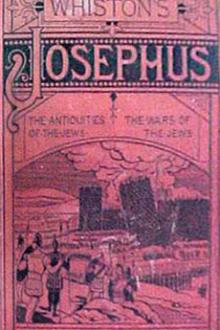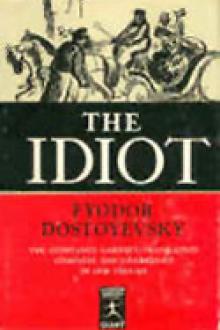The Antiquities of the Jews, Flavius Josephus [best books to read for young adults .txt] 📗

- Author: Flavius Josephus
- Performer: 1600964370
Book online «The Antiquities of the Jews, Flavius Josephus [best books to read for young adults .txt] 📗». Author Flavius Josephus
4. Now Solomon sent for an artificer out of Tyre, whose name was Hiram; he was by birth of the tribe of Naphtali, on the mother's side, [for she was of that tribe,] but his father was Ur, of the stock of the Israelites. This man was skillful in all sorts of work; but his chief skill lay in working in gold, and silver, and brass; by whom were made all the mechanical works about the temple, according to the will of Solomon. Moreover, this Hiram made two [hollow] pillars, whose outsides were of brass, and the thickness of the brass was four fingers' breadth, and the height of the pillars was eighteen cubits and their circumference twelve cubits; but there was cast with each of their chapiters lily-work that stood upon the pillar, and it was elevated five cubits, round about which there was net-work interwoven with small palms, made of brass, and covered the lily-work. To this also were hung two hundred pomegranates, in two rows. The one of these pillars he set at the entrance of the porch on the right hand, and called it Jachin 9 and the other at the left hand, and called it Booz.
5. Solomon also cast a brazen sea, whose figure was that of a hemisphere. This brazen vessel was called a sea for its largeness, for the laver was ten feet in diameter, and cast of the thickness of a palm. Its middle part rested on a short pillar that had ten spirals round it, and that pillar was ten cubits in diameter. There stood round about it twelve oxen, that looked to the four winds of heaven, three to each wind, having their hinder parts depressed, that so the hemispherical vessel might rest upon them, which itself was also depressed round about inwardly. Now this sea contained three thousand baths.
6. He also made ten brazen bases for so many quadrangular lavers; the length of every one of these bases was five cubits, and the breadth four cubits, and the height six cubits. This vessel was partly turned, and was thus contrived: There were four small quadrangular pillars that stood one at each corner; these had the sides of the base fitted to them on each quarter; they were parted into three parts; every interval had a border fitted to support [the laver]; upon which was engraven, in one place a lion, and in another place a bull, and an eagle. The small pillars had the same animals engraven that were engraven on the sides. The whole work was elevated, and stood upon four wheels, which were also cast, which had also naves and felloes, and were a foot and a half in diameter. Any one who saw the spokes of the wheels, how exactly they were turned, and united to the sides of the bases, and with what harmony they agreed to the felloes, would wonder at them. However, their structure was this: Certain shoulders of hands stretched out held the corners above, upon which rested a short spiral pillar, that lay under the hollow part of the laver, resting upon the fore part of the eagle and the lion, which were adapted to them, insomuch that those who viewed them would think they were of one piece: between these were engravings of palm trees. This was the construction of the ten bases. He also made ten large round brass vessels, which were the lavers themselves, each of which contained forty baths; 10 for it had its height four cubits, and its edges were as much distant from each other. He also placed these lavers upon the ten bases that were called Mechonoth; and he set five of the lavers on the left side of the temple 11 which was that side towards the north wind, and as many on the right side, towards the south, but looking towards the east; the same [eastern] way he also set the sea. Now he appointed the sea to be for washing the hands and the feet of the priests, when they entered into the temple and were to ascend the altar, but the lavers to cleanse the entrails of the beasts that were to be burnt-offerings, with their feet also.
7. He also made a brazen altar, whose length was twenty cubits, and its breadth the same, and its height ten, for the burnt-offerings. He also made all its vessels of brass, the pots, and the shovels, and the basons; and besides these, the snuffers and the tongs, and all its other vessels, he made of brass, and such brass as was in splendor and beauty like gold. The king also dedicated a great number of tables, but one that was large and made of gold, upon which they set the loaves of God; and he made ten thousand more that resembled them, but were done after another manner, upon which lay the vials and the cups; those of gold were twenty thousand, those of silver were forty thousand. He also made ten thousand candlesticks, according to the command of Moses, one of which he dedicated for the temple, that it might burn in the day time, according to the law; and one table with loaves upon it, on the north side of the temple, over against the candlestick; for this he set on the south side, but the golden altar stood between them. All these vessels were contained in that part of the holy house, which was forty cubits long, and were before the veil of that most secret place wherein the ark was to be set.
8. The king also made pouring vessels, in number eighty thousand, and a hundred thousand golden vials, and twice as many silver vials: of golden dishes, in order therein to offer kneaded fine flour at the altar, there were eighty thousand, and twice as many of silver. Of large basons also, wherein they mixed fine flour with oil, sixty thousand of gold, and twice as many of silver. Of the measures like those which Moses called the Hin and the Assaron, [a tenth deal,] there were twenty thousand of gold, and twice as many of silver. The golden censers, in which they carried the incense to the altar, were twenty thousand; the other censers, in which they carried fire from the great altar to the little altar, within the temple, were fifty thousand. The sacerdotal garments which belonged to the high priest, with the long robes, and the oracle, and the precious stones, were a thousand. But the crown upon which Moses wrote [the name of God] was only one, and hath remained to this very day. He also made ten thousand sacerdotal garments of fine linen, with purple girdles for every priest; and two hundred thousand trumpets, according to the command of Moses; also two hundred thousand garments of fine linen for the singers, that were Levites. And he made musical instruments, and such as were invented for singing of hymns, called Nablee and Cindree, [psalteries and harps,] which were made of electrum, [the finest brass,] forty thousand.
9. Solomon made all these things for the honor of God, with great variety and magnificence, sparing no cost, but using all possible liberality in adorning the temple; and these things he dedicated to the treasures of God. He also placed a partition round about the temple, which in our tongue we call Gison, but it is called Thrigcos by the Greeks, and he raised it up to the height of three cubits; and it was for the exclusion of the multitude from coming into the temple, and showing that it was a place that was free and open only for the priests. He also built beyond this court a temple, whose figure was that of a quadrangle, and erected for it great and broad cloisters; this was entered into by very high gates, each of which had its front exposed to one of the [four] winds, and were shut by golden doors. Into this temple all the people entered that were distinguished from the rest by being pure and observant of the laws. But he made that temple which was beyond this a wonderful one indeed, and such as exceeds all description in words; nay, if I may so say, is hardly believed upon sight; for when he had filled up great valleys with earth, which, on account of their immense depth, could not be looked on, when you bended down to see them, without pain, and had elevated the ground four hundred cubits, he made it to be on a level with the top of the mountain, on which the temple was built, and by this means the outmost temple, which was exposed to the air, was even with the temple itself. He encompassed this also with a building of a double row of cloisters, which stood on high upon pillars of native stone, while the roofs were of cedar, and were polished in a manner proper for such high roofs; but he made all the doors of this temple of silver. 12
CHAPTER 4. How Solomon Removed The Ark Into The Temple How He Made Supplication To God, And Offered Public Sacrifices To Him.
1. When king Solomon had finished these works, these large and beautiful buildings, and had laid up his donations in the temple, and all this in the interval of seven years, and had given a demonstration of his riches and alacrity therein, insomuch that any one who saw it would have thought it must have been an immense time ere it could have been finished; and would be surprised that so much should be finished in so short a time; short, I mean, if compared with the greatness of the work: he also wrote to the rulers and elders of the Hebrews, and ordered all the people to gather themselves together to Jerusalem, both to see the temple which he had built, and to remove the ark of God into it; and when this invitation of the whole body of the people to come to Jerusalem was every where carried abroad, it was the seventh month before they came together; which month is by our countrymen called Thisri, but by the Macedonians Hyperberetoets. The feast of tabernacles happened to fall at the same time, which was celebrated by the Hebrews as a most holy and most eminent feast. So they carried the ark and the tabernacle which Moses had pitched, and all





Comments (0)